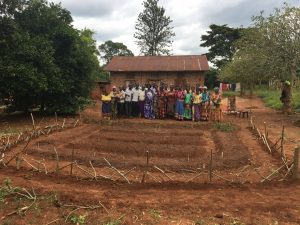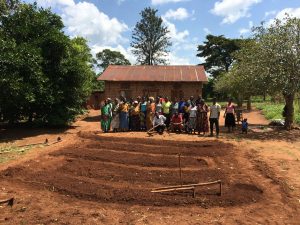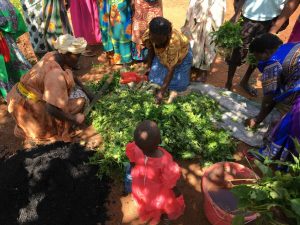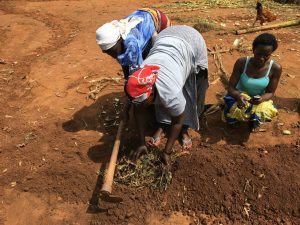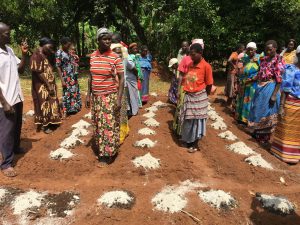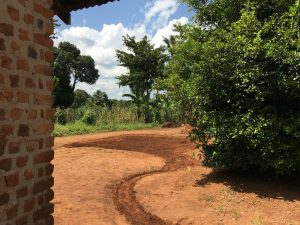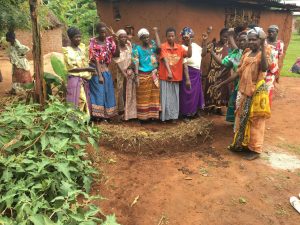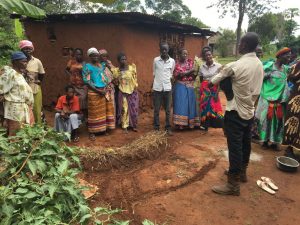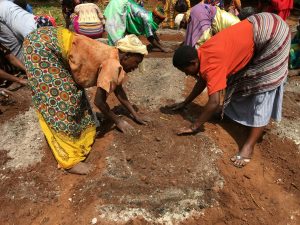This project is made possible through the partnership of WATER CHARITY and the NATIONAL PEACE CORPS ASSOCIATION. ![]()
This project has been completed. To read about the conclusion, CLICK HERE.
The eighth training of our Permagarden Training Initiative – Worldwide will take place in June – July 2018. Peter Jensen will train community volunteers with his Terra Firma Permagardens for Empowerment and Resilience course. Here is an outline of what will be accomplished in the training.
What:
To provide a complete, hands-on, Four Day Terra Firma Permagarden Creation and Outreach Training
Trainer:
Peter Jensen, RPCV (Haiti, 1985-87), Agroecology and Permagarden Training Specialist. Peter will be working with Gerald Nkusi, ALCDI Uganda, as a training assistant and co-facilitator.
Host and Local Direction:
Andrew Gabula, who heads up Uganda Rural Information and Communication Technology (URICT), a registered charitable organization.
Where:
Kamuli, Uganda
When:
June 30 – July 7, 2018
Who:
25 community outreach volunteers of URICT
Summary:
25 community volunteers will be trained over 4 days on how to create and teach the standard 3x3m Permagarden as well as the new innovation, the Terra Firma Keyhole. The keyhole is a small-scale version of the Perma garden which is particularly suited for the corners of outdoor kitchens and those families with extremely small land availability. The keyhole still teaches all the Terra Firma Agroecological lessons of resource assessment, carbon capture, water management, and bio-intensive soil health management and intensive plant spacing as taught in the standard Permagarden.
URICT staff will provide monthly follow up site visits with all trained individuals and encourage the continuing outreach of this small, doable action-oriented, nutrition security and water management approach.
The step by step Terra Firma Method will be used throughout to guide learners and future trainers on how to make the most suitable all-organic, water-conserving, nutrition-focused, home garden for this particular climate and culture.
Terra Firma guides the learner to make the most informed agroecological-appropriate garden but can also be used intersectoral in public health, youth development, and small enterprise development situations as well.
All actions within the workshop will foster independence rather than dependence upon outsiders to continue. The Terra Firma method uses only the tools, plants and soil amendments that are already locally accessible to targeted beneficiaries, namely rural poor farmers, mothers, and children, enabling further adoption within the local community following training by these soon to be trainers.
The farming people of this community are struggling with poor soil and insecure weather conditions. Child malnutrition is high due to a lack of access to nutritious crops in the markets. The land is hard and infertile and there is no mechanism in place to direct water from the roofs to gardens.
Permagardens and Keyhole gardens will help to put an end to the access challenge while also reducing the insecurity of climate change. Runoff water will be focused and directed to the gardens where it will be fully absorbed and saved for periods of no rain.
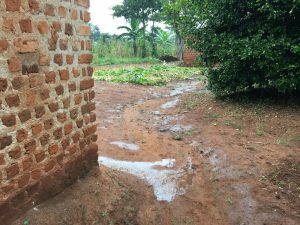
Water loss pathway 1: Roof runoff can’t enter the garden.
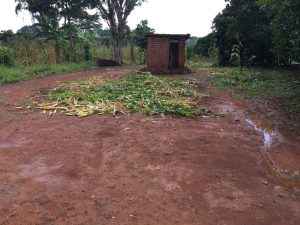
Water loss pathway 2: The garden maize removed so as to allow for garden re-creation in the days to come. runoff water will be directed in a swale along the top of the garden rather than being lost to the lower side from the beginning.
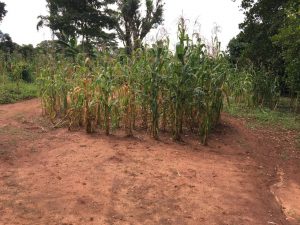
Garden Before: This garden is extremely drought-stressed despite being grown during an abundant rainy season. Poor soil quality and lack of adequate water capture are to blame. Swales will redirect runoff water turning this garden area into a ‘water tank’ holding water for periods of limited rainfall.
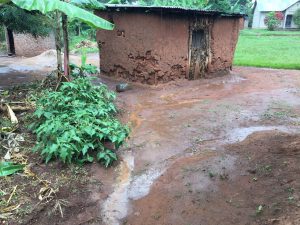
Keyhole Before: roof water runs off and down the slope when it could be collected in the soil at the very corner where the runoff joins allowing for a small but highly productive garden and lessening the flow of runoff being lost further down the slope.
Follow-up within 3 months of training will be reported to show onward adoption of this simple yet empowering methodology. 60 home gardens are anticipated within this first period, benefiting 7 people per garden, for an expected total of over 400 persons. A full year later this figure will be expected to be near 200 gardens, resulting in outreach to over 1,500.
Your donation using the button below will be used for the next Permagarden project.
 Conclusion of URICT Permagarden Training – Uganda
Conclusion of URICT Permagarden Training – Uganda
This project has been completed under the direction of Peter Jensen, Agroecology and Permagarden Training Specialist. The training was hosted and locally organized by Andrew Gabula, who heads up Uganda Rural Information and Communication Technology (URICT)). Gerald Nkusi, ALCDI Uganda, worked as a training assistant and co-facilitator.
To read about the start of the project, CLICK HERE.
Peter reports:
We had a marvelous week in Kamuli, alongside Andrew Gabula and his team from URICT: Uganda Rural Information and Communication Technology. A marvelous use of the ICT label to highlight the transfer of knowledge and skills amongst the marginalized women and children within their target region of Kamuli, Uganda. The 25 community volunteers (20 women, 5 men) fully embraced the Terra Firma agroecological concepts and are motivated to take these ideas and ‘communicate’ them well throughout their village farming community.
They worked easily side by side and plan to work in groups of 5 to create permagardens and the keyholes at each other’s homes within this month before the major rains return in late August. They will pull in other women who were not able to attend the training this week by using the statement, “come, help us build a water tank in our soil!’ They really do seem to get this message that while a roof water catchment tank would be wonderful, they are currently beyond the realm of possibility for the average family home. But the idea that a well-adapted and mitigated garden plot can hold the water off the roof for ‘eating water’ was highly motivational.
Full Garden After: Complete with Moringa living fence, 4 berms and swales and 3 fully double dug, carbon amended and planted with legume garden beds. This is the symbol of empowerment and resilience.
Adaptation: Here we see the result of the garden clearing and water management mapping and the single digging of all the berms and beds. Next step will be to double dig and amend all of it. This initial step took the group just 3 hours to go from poor maize harvest to adapted garden space. All the runoff is now directed to the high end of the garden on the right where it will be under control and slowly sink and be saved for the periods of little or no rain.
Garden Clearing: We were pleased to have the whole family get involved in each step of the process. The garden area needs to be lightly cultivated so as to properly assess the water management pathways.
Making Compost: The gathered brown materials must be blended with local green leaves to get the proper blend of carbon and nitrogen for proper composting. The group learned how to make and manage a cubic meter pile and make a new one every 2 weeks.
Subsoil Feeding: Carbon rich local waste leaves and charcoal is added to the subsoil to increase soil health and water retention capacity.
Topsoil Feeding: Using only local waste materials the women learned how to best feed the topsoil for improved soil and plant health.
Water Control Pathway: Rather than being lost, all roof and pathway runoff water will now be guided slowly and easily to the garden where it will sink and spread and be saved deep within the subsoil. This is how the garden becomes an “eating water tank”.
TF Keyhole After: When space is limited and learners are reluctant to change, we use the Keyhole method to teach all the lessons of the larger permagarden but in a way that people can slowly watch and learn. This is a real game changer for behavior change.
Gerald Explains: Once the initial keyhole is created the mothers learn that, if desired, a further garden bed could be created below it.
Topsoil Care: Once the garden has been adapted to catch the rain and double dug and amended to hold the water, the topsoil management and crop rotation is all that is required year to year. The Permagarden, once created, need only be managed. It never needs to be double dug again, so long as good management practices like crop rotation and swale cleaning and compost additions continue.
We extend our thanks to Peter for completing this important project.
